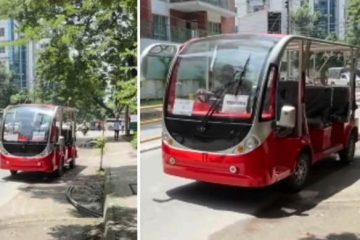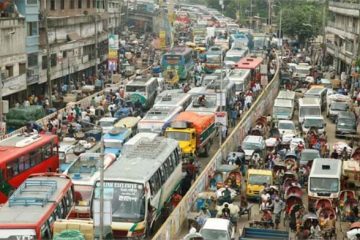From NewAgebd
 Reckless driving and regular violation of traffic rules by drivers have put lives of pedestrians in the city in danger.
Reckless driving and regular violation of traffic rules by drivers have put lives of pedestrians in the city in danger.
Mindless competition particularly between public transports is a common sight in the city streets with authorities having no control over the situation, city dwellers said. The government should draw up a comprehensive plan to rid the capital of chaotic traffic and curb fatal road accidents, they said.
The tragic deaths of Willes Little Flower’s six-year-old student Hamim Sheikh and another boy under the wheels of buses in a span of 72 hours seem to have failed to arouse any guilt feelings in the traffic authorities.
Reckless driving claimed lives of two more children in the city and Gazipur on its outskirts in last two days after Hamim was run over by a bus on Wednesday.
In the city, six-year-old Sumi, daughter of Hasina Begum and Manju Sarder of Nakhalpara area, died when a speeding vehicle ran over her near the Prime Minister’s Office on Friday.
In Gazipur on Thursday, six-year-old Sujon, a kindergarten boy, was run over by a speeding bus on Dhaka-Tangail Highway at Hotapara while he was crossing the road along with his elder brother.
There are more than six thousand different types of educational institutions in the capital and at least 80 per cent of them are located by the 1,800 kilometres main streets, the education ministry sources said.
The government a few months back gave instructions to the authorities concerned to take steps to avoid traffic congestion in front of educational institutions.
The deputy commissioner, traffic (east), of Dhaka Metropolitan Police, Awlad Hossain, told New Age, ‘The DMP often launches awareness campaigns for pedestrians and commuters and also imparts some training to drivers at our own initiative though it is not the sole responsibility of the DMP to curb road crashes,’ said.
‘There are so many educational institutions in the city and a large number of them are situated by the busy roads. There is no particular plan to prevent accidents in front of the educational institutions,’ he conceded.
Reacting to such comments, Kazi Zakaria Islam, a researcher at the accident research institute at Bangladesh University of Engineering and Technology, told New Age that callous mismanagement of the traffic system and lack of proper enforcement of the traffic rules were mainly responsible for the situation.
He said it seemed there was nobody to stop the unskilled drivers from desperate attempts to overtake each other.
‘Law enforcers have completely failed to take action against reckless driving,’ he said adding that most accidents were caused by reckless driving rather than mechanical failure.
‘I do not understand who allows drivers to operate unfit and unauthorised vehicles,’ the BUET researcher said.
Referring to the death of the schoolboy on Wednesday, Zakaria said that like the bus driver Shamsur Rahman, who killed the boy, most of the underage and unskilled drivers were driving buses with fake licences.
Most of the buses ply the city roads without rear-view mirror and side-indicators.
When asked how such unfit vehicles had obtained permission to ply the city roads, Bangladesh Road Transport Authority director [enforcement] Tapan Kumar Sarker told New Age that they enforce the laws with the help of the police.
‘When we go for a drive we do not find any such [unfit] vehicles and it seems information of such plans is leaked out to transport owners in advance. Only the police can do something about it if they are sincere about easing the people’s sufferings,’ he said.
When asked about fake licences, the director of the national transport regulatory body said, ‘We know the BRTA’s licences are highly secure in terms of technology. But, if any syndicates manage to produce fake licences why do intelligence agencies shut their eyes to it?’
An office-bearer of the Association of Bus Companies on Wednesday said, ‘We do not bother about what the law says as we know the police and can manage them.’
Transport owner and vice-president of ABC [a platform of owners of six thousand buses] Syed Rezaul Karim said that the government should take effective steps to train the drivers and transport staffs on driving with caution.
‘DMP and some other organisations often launch awareness campaigns but that is too insufficient for a large number of skilled and unskilled drivers in the city,’ Karim said.
When approached for comments, additional deputy commissioner of DMP Walid Hossain said police had been deployed to enforce the laws.
Sarwar Jahan, head of BUET’s urban and regional planning department, said most pedestrians did not use footbridges particularly in front of educational institutions for many reasons.
‘Most of the footbridges are too dirty for use by pedestrians while many people prefer to cross the road as a short cut to avoid the trouble of using footbridges,’ he said, adding, ‘The DCC authorities should properly monitor the cleaning activities.’
Sarwar Jahan said that the government should not allow anyone to set up educational institutions beside roads.
There are bout 50 footbridges in Dhaka city. Of them, only five are in front of the educational institutions. The DCC and Rajdhani Unnayan Kartripakkha have built some of them and the rest have been set up under the World Bank’s Dhaka Urban Transport Project and crash programmes.
According to the data available, 45 people are killed on an average in road accidents mostly involving buses across the country every month.
According to the DMP, over the last three months around 500 fake driving licences have been seized. A deadline has been set for drivers to obtain genuine licences by March 31.
The DMP has said it will go tough on drivers carrying fake licences after the deadline.
DMP sources said 498 road accidents resulted in the death of 295 people between January and November 2009, and since August 2009 a total of 13,366 unfit vehicles were seized but all but 1,500 were released due to lack of dumping space.

















